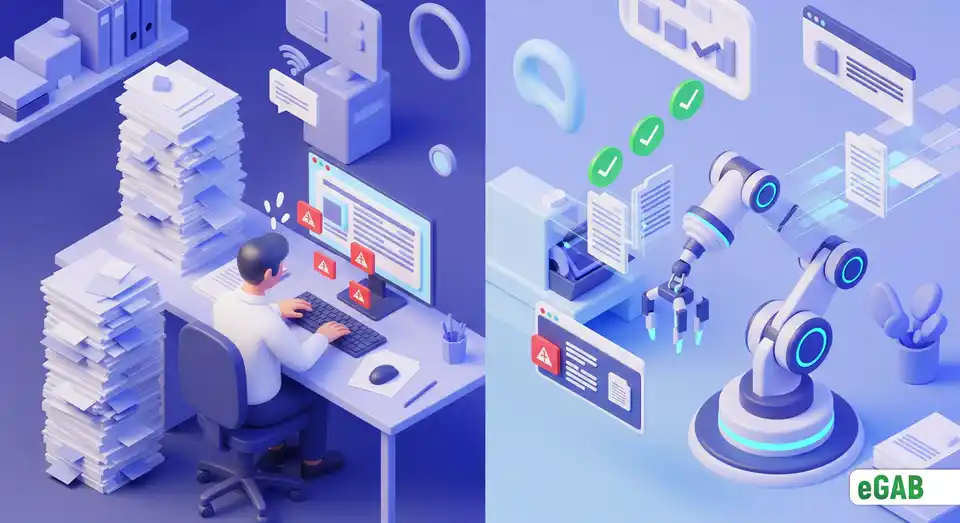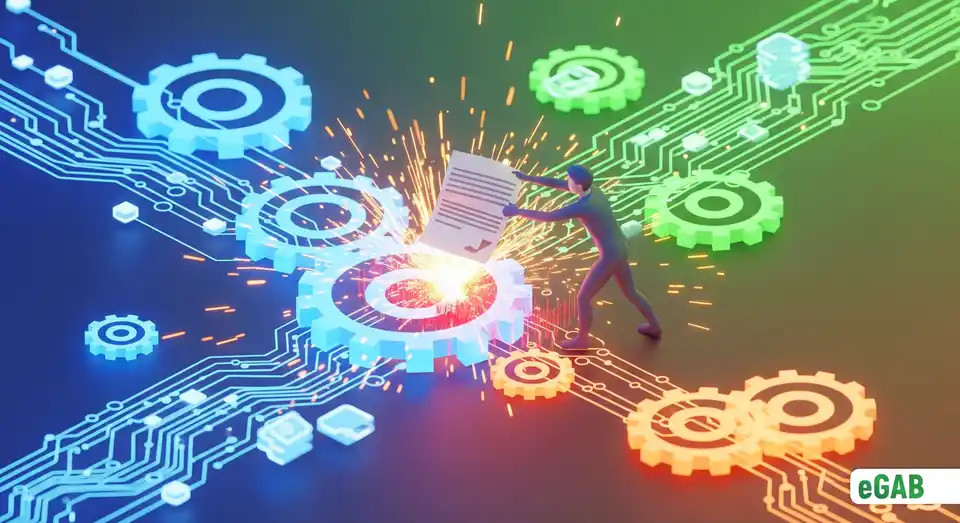The Ultimate Bottleneck: How Paper-Based Processes Are Killing Your Business Automation

 Author:
Artem Grigoriev
Author:
Artem Grigoriev
Have you ever invested in powerful new software? Maybe you've even trained your team on agile methods. But does your business still feel like it’s stuck in slow motion? While you’re pushing for speed, something is quietly hitting the emergency brake on your progress. That invisible force isn't a flaw in your strategy. It's the ultimate bottleneck hiding in plain sight: your reliance on paper-based processes . These legacy workflows are the silent killer of business automation . They create friction and frustrating delays. And this completely undermines your valuable investments in digital transformation. This article will break down exactly how paper cripples your operations. We’ll look at how it stalls critical approval chains, cover costly manual data entry errors, and examine its fundamental inability to integrate with the modern systems designed to run your company.
📘 This post is part of our comprehensive guide to "The Problems with Paper Documents: A Complete Guide". Explore it to find answers to all your questions ;)
How Do Physical Documents Stall Critical Approval Chains?
Has a game-changing project ever ground to a halt for you, just because you were waiting for a single piece of paper to be signed? We've all been there. It’s that sinking feeling when your team's momentum is stopped dead in its tracks. This classic approval workflow bottleneck is one of the most common business automation bottlenecks that companies face. This isn't just a minor inconvenience-it's a fundamental flaw in how paper-based processes work and a massive drag on your company's agility .
Here's the reality: any process that relies on a physical document is inescapably chained to its physical journey. That piece of paper has to be hand-carried or mailed from desk to desk, across departments, or even to different cities, a process that shows why a paper-based office is failing your remote team. This journey creates unpredictable and often huge time lags at every single step of your workflow. This brings up a critical question: how do paper processes slow down a business? The answer is that the entire system is built on outdated physical document management , a process that simply wasn't designed for the speed of modern business.
It's no surprise, then, what experts at the Association for Intelligent Information Management (AIIM) are finding. Businesses consistently name the time-consuming nature of paper as a top challenge, with employees often spending hours every week just looking for the documents they need. Many companies also point directly to having "too many steps" in their manual approval processes. The impact on project delivery is staggering. It's not uncommon for projects to be significantly delayed-we’re talking about a five-month project being held up for a full month, all because of shuffling paper and waiting for signatures.
But perhaps the most frustrating of all the disadvantages of paper documents is the complete lack of visibility . With a paper document, you're essentially flying blind. Is it sitting on someone's desk? Lost in interoffice mail ? Buried under a stack of other files, demonstrating the hidden risks of your filing cabinet? While digital systems give you real-time tracking, paper leaves your team completely in the dark. This makes it impossible to pinpoint where the delay is coming from. So, what are the main bottlenecks in approval processes? They almost always boil down to the physical journey of the document and its need for manual handling. To make matters worse, every time that paper is handed off, there's a new risk it could get lost, damaged, or misplaced-requiring a disaster-proof document strategy-forcing you to start the whole time-consuming process all over again. Ultimately, it all comes back to a single, outdated requirement: the sequential need for "wet ink" signatures . While modern e-signatures can complete this step in seconds, the demand for a wet signature acts as a hard stop. This antiquated practice creates a rigid, one-at-a-time bottleneck where the entire workflow stops cold, just waiting for one person to act.
Try This: For one week, track a single approval document on its physical journey through your company. Note how long it sits on each desk and the total time from start to finish. The results will likely shine a spotlight on exactly where your biggest operational bottlenecks are hiding.

Why Does Manual Data Entry Cripple Workflow Efficiency?
In the business world, manual data entry is the silent productivity killer. These pervasive manual data entry problems are a huge source of the true cost of paper and a major roadblock to effective workflow efficiency . It's a slow, repetitive task that eats up thousands of your team's hours every year. Think about that: those are valuable hours your skilled employees could be pouring into strategic work -like planning and problem-solving-that actually grows your business. But honestly, the wasted time, which is a massive drain on your operational efficiency , is just the beginning of the problem.
Let's be candid: the process is dangerously prone to human error, which puts the integrity of your data at serious risk, one of several critical data security risks of paper documents. Even your most careful employees make mistakes. In fact, studies show that manual data entry error rates can be as high as 4% . That might not sound like a big deal, but let's do the math on what it really costs you. If your team handles 10,000 transactions a month, a 4% error rate creates 400 costly mistakes . Since it costs over $50 to fix a single error, you're suddenly looking at $20,000 in losses every single month . Annually, that balloons to a staggering $240,000 per year -money you're spending just to fix preventable typos. This directly answers a critical question for any finance department: how much does manual invoice processing cost? A lot more than you think.
This inefficiency is simply baked into the cost of using paper. A benchmark report, The State of ePayables 2024 by Ardent Partners , reveals just how high the average cost to manually process a single invoice is compared to the savings from automation. This is a key reason why accounts payable automation delivers such a quick and significant return on your investment. So, if you're handling 12,000 invoices a year, you're looking at an enormous and unnecessary expense. Despite these clear numbers, the problem is still shockingly common, as a huge number of companies still rely on outdated spreadsheets or paper forms to capture their data.
Beyond the hard costs, there's also a significant human toll. Assigning your talented employees to tedious, repetitive data entry is a perfect recipe for low job satisfaction and higher turnover . So, what are the risks of manual data entry? They include not only financial loss and bad data but also a demoralized workforce, which disrupts your business and drives up hiring costs. The bottom line is clear: trying to scale an operation built on manual data entry is completely unsustainable. It means your headcount has to grow right alongside your workload, creating an expensive and inefficient barrier to growth.
Takeaway: Manual data entry isn't just a "cost of doing business." It's a tax on your efficiency and a huge risk to your data. By automating how you capture data, you take the first critical step in manual process automation . You're not just cutting costs-you're freeing your team to focus on innovation and stopping expensive errors before they ever happen.

Why Can't Paper Integrate With Automated Business Systems?
Ever tried to fuel a new electric car with gasoline? It's a non-starter, right? That’s exactly what happens when you try to force paper documents into your modern business systems. At its core, paper is completely incompatible with your digital tools. It can't connect to your software's APIs (Application Programming Interfaces that let programs talk to each other), kick off automated tasks, or update your databases in real-time. It's an analog tool in a digital world, and every time it shows up, it shatters the chain of automation. This makes the goal of automating paper workflows feel impossible. Ultimately, this is what stops you from achieving true digital transformation -the complete overhaul of your business using digital tech. Any digital transformation strategy that doesn't tackle paper head-on is simply doomed to fail.
Your automated systems need structured, accessible digital data (info that's organized so computers can read it) to work their magic. So, can you integrate paper documents with software like ERP or CRM? The short answer is a hard no-not directly. Paper, by its very nature, creates "fragmented data silos" -isolated islands of information that are completely invisible to your other systems. This disconnect paralyzes your operations, slows down decision-making, and makes it impossible to get a clear, unified view of your business. Even if you have a great document management system (DMS) , paper documents stay outside your digital world until someone manually scans and processes them. You can't see what’s happening across your ERP (Enterprise Resource Planning) and CRM (Customer Relationship Management) systems , and that creates huge hidden labor costs. In fact, some studies estimate this costs thousands of dollars per manager every year, all from time wasted manually updating different systems and trying to connect the dots.
Any workflow with a paper step has a built-in hard stop. The second you have to scan a document, manually type in its data, and then check for errors, you've already lost. This manual data capture is the exact point where automation fails. That one sequence kills any chance you had of a smooth, end-to-end automated process. By not getting rid of paper, companies are leaving huge value on the table. As analysts from McKinsey & Company explain about capturing automation's value , successful automation done at scale (across the whole organization) delivers a massive return on investment (ROI) , often within the very first year.
Now, you might be thinking, "But what about scanning?" It's true that companies use Optical Character Recognition (OCR) technology to try and bridge this analog-to-digital gap. But here's the catch: OCR is just a temporary band-aid, not a real solution. So, is scanning documents a true form of automation? Not really. Because OCR is rarely 100% accurate, you almost always need a person to double-check its work. This just brings back the manual bottleneck-the very problem that intelligent workflows are designed to eliminate. This perfectly highlights one of the core workflow automation challenges : how do you handle inputs your system can't natively read?
Quick Insight: True automation isn't just about speeding up one step. It's about creating an unbroken, intelligent flow of information from start to finish. As long as paper is part of that flow, you'll always have a bottleneck that kills your speed, efficiency, and growth potential.

How eGAB Serves as the Foundation for True Automation
Let's be honest: paper is the enemy of automation . Every physical document that enters your workflow creates a hard stop, forcing someone to manually scan, interpret, and verify it. This is the ultimate bottleneck that kills any chance of true end-to-end automation. eGAB removes that obstacle completely.
By providing a machine-readable , instantly verifiable digital format, eGAB lets your documents flow seamlessly through any automated workflow. From employee onboarding and compliance checks to invoicing and logistics, the entire process can finally run without a single interruption.
The platform's API integrates deeply with the business systems you already use, including your ERP, CRM, and HRIS platforms. This means you can build fully automated processes triggered and validated by trusted, verifiable data. You’re no longer just speeding up one step; you're creating intelligent, resilient workflows that run on a foundation of absolute trust.
Your Next Step: Pinpoint the single most painful paper-based workflow in your organization. Is it processing invoices? Onboarding new employees? By targeting that one bottleneck and replacing it with an eGAB-powered automated process, you can build a powerful case study to drive digital transformation across your entire company.

Summary: Breaking Free from the Paper Bottleneck
So, what's the final verdict on paper in the modern workplace? Let's be direct: paper is the anchor holding your business back. It's a fundamental bottleneck that systematically sabotages every attempt you make at real automation. We've seen how any process relying on a physical document is instantly crippled simply because it has to be physically moved around. This inevitably creates the classic approval workflow bottleneck , a situation where projects grind to a halt, waiting for a piece of paper to be hand-carried or for a "wet ink" signature . This isn't just an inconvenience; it's a complete loss of both agility and visibility , leaving your team operating in the dark and unable to find the source of delays.
Beyond the logistical nightmare, paper forces your business into the slow, costly, and notoriously error-prone world of manual data entry . This isn't just a drain on your workflow efficiency ; it's a direct threat to the integrity of your data . Seemingly small error rates can quickly balloon into hundreds of thousands of dollars in preventable losses each year. When you consider the staggering cost of manual invoice processing and the profoundly negative impact it has on employee morale and turnover , it becomes crystal clear: you can't build a scalable operation on such a broken foundation.
Ultimately, paper's most critical failure is its complete lack of integration. As an analog relic in a digital world, paper simply can't communicate with your critical ERP and CRM systems . This disconnect creates fragmented data silos , making a unified, big-picture view of your business impossible. As a result, achieving a seamless, end-to-end automated process is simply off the table. Even common workarounds like scanning and OCR (Optical Character Recognition) are just band-aids. Why? Because they reintroduce a manual verification step-the very thing modern intelligent workflows are designed to eliminate. So, to achieve true digital transformation -a future that will rely on innovations like Verifiable Credentials-and unlock a significant ROI (Return on Investment), the conclusion is inescapable: your business must move beyond paper. As long as paper remains in your process, you'll always be shackled to a costly, inefficient, and entirely preventable bottleneck.
➡️ What's the next step? The inability to automate directly impacts modern workforces. Understand why your paper-based office is failing your remote team.

Why Public NFT Platforms Are the Wrong Choice for Academic Credentials
Why an In-House Credential Verification System Is a Mistake for Universities
The Anatomy of a Fake: A Deep Dive into Modern Document Forgery
Verifying International Diplomas: Why It’s Broken and How to Fix It
The Hidden Risks of Your Archive: A Guide to Secure Document Storage
